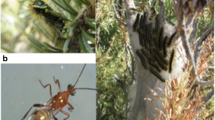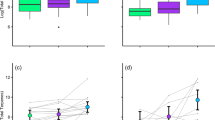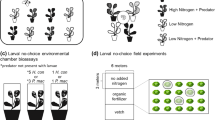Abstract
Lodgepole pine (Pinus contorta) trees of two different seed origins, one a poor quality host (Alaskan lodgepole pine), the other a good quality host (south coastal lodgepole pine), were infested with known numbers of eggs of the pine beauty moth, Panolis flammea. Each tree had paired sleeves, one allowing access by invertebrate predators, the other denying this access. When the sleeves were removed, the numbers of larvae surviving, their weights and developmental stages were assessed. Larvae reared on south coastal lodgepole pine (SLP) in the absence of predators were significantly heavier and had significantly better survival rates than larvae reared in comparable conditions on Alaskan lodgepole pine (ALP). However, in the open sleeves, although the larvae reared on SLP were significantly heavier than those on ALP, survival was significantly greater on ALP. Thus predation was greater on the faster develo** larvae on the better quality host. These results indicate that slow growth by a herbivore does not necessarily result in greater vulnerability to predators.
Similar content being viewed by others
References
Ballard J (1987) Larval behaviour of the pine beauty moth. In: Leather SR, Stoakley JT, Evans HF (eds) Population biology and control of the pine beauty moth (Forestry Commission Bulletin 67) HMSO, London, pp 31–36
Berenbaum MR (1983) Effects of tannins on growth and digestion in two species of papilionids. Ent Exp Appl 34: 245–250
Bernays EA (1978) Tannins: an alternative viewpoint. Ent Exp Appl 24: 244–253
Bernays EA (1981) Plant tannins and insect herbivores: an appraisal. Ecol Entomol 6: 353–360
Bernays EA, Woodhead S (1982) Plant phenols utilized as nutrients by a phytophagous insect. Science 216: 201–202
Clancy KM, Price PW (1987) Rapid herbivore growth enhances enemy attack: sublethal plant defences remain a paradox. Ecology 68: 733–737
Damman H (1987) Leaf quality and enemy avoidance by the larvae of a pyralid moth. Ecology 68: 88–97
Entwistle PF, Evans HF (1987) Trials on the control of Panolis flammea with a nuclear polyhedrosis virus. In: Leather SR, Stoakley JT, Evans HF (eds) Population biology and control of the pine beauty moth (Forestry Commission Bulletin 67) HMSO, London, pp 61–68
Feeny P (1970) Seasonal changes in oak leaf tannins and nutrients as a cause of spring feeding by winter moth. Ecology 51: 565–581
Feeny P, Blau WS, Kareiva PM (1985) Larval growth and survivorship of the black swallowtail butterfly in central New York. Ecol Monogr 55: 167–187
Grossmueller DW, Lederhouse RC (1985) Oviposition site selection: an aid to rapid growth and development in the tiger swallowtail butterfly, Papilio glaucus. Oecologia 66: 68–73
Herrebout WM, Kuyten PJ, DeRuiter L (1963) Observations on colour patterns and behaviour of caterpillars feeding on Scots pine. Arch Neerl Zool 15: 315–357
Hurlbert SH (1984) Pseudoreplication and the design of field experiments. Ecol Monogr 54: 187–211
leather SR (1984) The effect of adult feeding on the fecundity, weight loss and survival of the pine beauty moth, Panolis flammea (D&S). Oecologia 65: 70–74
Leather SR (1985) Oviposition preferences in relation to larval growth rates and survival in the pine beauty moth, Panolis flammea. Ecol Entomol 10: 213–217
Leather SR (1990) Two case studies: the pine beauty moth and the bird claey aphid. In: Burdon JJ, Leather SR (eds) Pests pathogens and plant communities. Blackwell Scientific Publications. Oxford, pp 145–167
Leather SR, Brotherton CM (1987) Defensive responses of the pine beauty moth, Panolis flammea (D&S), (Lepidoptera: Noctuidae). Entomol Gaz 38: 19–24
Leather SR, Burnand AC (1987) Factors affecting life-history parameters of the pine beauty moth, Panolis flammea (D&S): the hidden costs of reproduction. Funct Ecol 1: 331–338
Loader C, Damman H (1991) Nitrogen content of food plants and vulnerability of Pieris rapae to natural enemies. Ecology 72: 1586–1590
Price PW, Pschorn-Walcher H (1988) Are galling insects better protected against parasitoids than exposed feeders?: a test using tenthredinid sawflies. Ecol Entomol 13: 195–205
Price PW, Bouton CE, Gross P, McPheron BA, Thompson JN, Weis AE (1980) Interactions among three trophic levels: influence of plants on interactions between insect herbivores and natural enemies. Annu Rev Ecol Syst 11: 41–65
Raupp MJ, Denno RF (1983) Leaf age as a predictor of herbivore distribution and abundance. In: Denno RF, McClure MS (eds) Variable plants and herbivores in natural and managed systems. Academic Press, New York, pp 91–124
Schultz JC (1983) Impact of variable plant defensive chemistry on susceptibility of insects to natural enemies. Am Chem Soc Symp Series 208: 37–54
Scriber JM (1981) Sequential diets, metabolic costs and growth of Spodoptera eridania (Lepidoptera: Noctuidae) feeding upon dill, lima bean, and cabbage. Oecologia 51: 175–180
Stamp NE, Bowers MD (1988) Direct and indirect effects of predatory wasps (Polistes sp: Vespidae) on gregarious caterpillars (Hemileuca lucina: Saturniidae). Oecologia 75: 619–624
Stoakley JT (1979) The pine beauty moth — its distribution, life cycle and importance as a pest in Scottish forests. In: Holden AV, Bevan D (eds) Control of pine beauty moth by fenitrothion in Scotland. Forestry Commission Occasional Paper 4: 7–12
Strong DR, Lawton JH, Southwood TRE (1984) Insects on plants, Blackwell Scientific Publications, Oxford
Watt AD (1987) The effect of shoot growth stage of Pinus contorta and Pinus sylvestris on the growth and survival of Panolis flammea larvae. Oecologia 72: 429–433
Watt AD (1989) The growth and survival of Panolis flammea larvae in the absence of predators on Scots pine and lodgepole pine. Ecol Entomol 14: 225–234
Zucker WV (1983) Tannins: does structure determine function? Am Nat 121: 335–365
Author information
Authors and Affiliations
Rights and permissions
About this article
Cite this article
Leather, S.R., Walsh, P.J. Sub-lethal plant defences: the paradox remains. Oecologia 93, 153–155 (1993). https://doi.org/10.1007/BF00317663
Received:
Accepted:
Issue Date:
DOI: https://doi.org/10.1007/BF00317663




